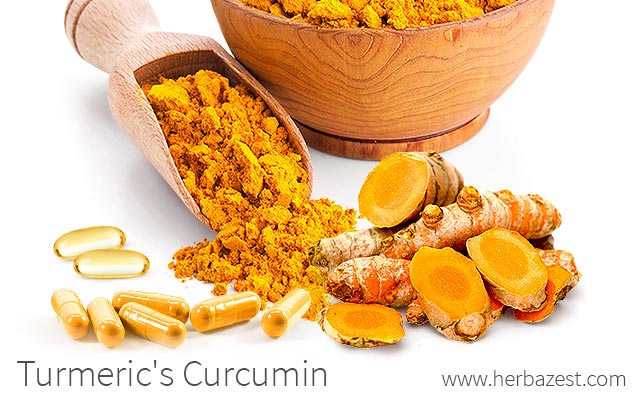Often confused with the name of the plant itself, curcumin is a naturally-occurring carotenoid present in the turmeric rhizome or root and, to a lesser extent, in many other plants in the Zingiberaceae family. It is thought to be the source of the many turmeric benefits.
What is Curcumin?
Harvard scientists Vogel and Pelletier were the first to isolate a yellow coloring-matter from the fresh root of the turmeric plant two-hundred plus years ago. In 1910, the chemical structure of the compound - which they had named curcumin - was further studied and found to be diferuloylmethane, an anti-inflammatory agent whose mechanism of action is yet to be fully understood.
The first clinical trial with curcumin was performed by a physician named Albery Oppenheimer in 1937. Oppenheimer studied curcumin benefits for the treatment of human biliary disease, a disorder affecting the gallbladder. The results of this pioneer study showed that curcumin is able to increase bile flow activity.
These early findings suggested the therapeutic value of turmeric's curcumin; however, it wasn't until the 1970's that scientific curiosity really began to take root, when three separate studies discovered curcumin anti-inflammatory, antidiabetic, antioxidant, and anti-cholesterolemic properties.
Amount of Curcumin in Turmeric
Phenolic acids called curcuminoids account for roughly 2 - 9% of turmeric's overall composition and are responsible for its distinctive golden color. There are three major curcuminoids found in turmeric. Of these, curcumin is the most abundant, making up about 75% of them.
COMPARED TO THOSE ON OTHER CONSTITUENTS OF TURMERIC, CURCUMIN STUDIES ABUNDANT, SINCE THIS COMPOUND IS OF GREAT INTEREST FOR THE SCIENTIFIC COMMUNITY.
A study published in the International Research Journal of Pharmacy (2011) found that curcumin content varies in fresh and stored turmeric rhizomes at about 3 - 5%. An earlier study from Nutrition and Cancer (2006) yielded similar results, showing pure turmeric powder to contain about 3.14% curcumin by weight. These curcumin levels were significantly higher than those which could be found in curry powders and other types of commercial blends.
Despite these findings, when it comes to the amount of curcumin in turmeric, it should be noted that curcumin content will be highly dependent on specific cultivars.
Curcumin Nowadays
Since the benefits of curcumin for reducing inflammation, alleviate arthritis symptoms, and lower cholesterol as well as blood sugar levels were discovered in the 1970s, it would seem that curcumin has finally begun to enjoy its time in the limelight.
A plethora of both human and pre-clinical studies - many of which are ongoing - has been conducted in order to further assess curcumin's mechanisms of action and efficacy. For example, in a breakthrough study published in the Indian Journal of Medical Research (1980), the benefits of curcumin for arthritis were found to be similar to those of phenylbutazone, a then-popular drug used to treat rheumatoid arthritis, which has since been discontinued for human use due to its high toxicity.
SCIENTIFIC FINDINGS HAVE SPARKED AN UNDENIABLE WAVE OF ENTHUSIASM ABOUT CURCUMIN BENEFITS THAT HAS PREVAILED THROUGHOUT THE LAST TWO DECADES.
Nowadays, a three- to four-month supply of curcumin supplements can be purchased for as little as $30 USD. Capsules are formulated with other chemical compounds to increase curcumin bioavailability and absorption into the bloodstream.
While not yet endorsed by the Federal Drug Administration (FDA), curcumin supplements can be a much safer alternative in the treatment of certain gastrointestinal, rheumatic, and hepatic disorders when compared to some conventional drugs. Curcumin supplements are available in many countries, including India, the United Kingdom, the United States, Korea, South Africa, China, and Japan.
When it comes to the colorful root vegetable turmeric, curcumin is hands-down the most important constituent. The primary source of turmeric's medicinal actions, curcumin and other curcuminoids are vital compounds that are every bit worthy of the attentiveness they have been paid by the scientific community.
Sources
- Bioactive food as dietary interventions for arthritis and related inflammatory diseases, p. 622
- Clinical and Experimental Pharmacology & Physiology, Discover of Curcumin, a component of golden spice, and its miraculous biological activities, 2012
- International Research Journal of Pharmacy, Comparative studies on curcumin content in fresh and stored samples of turmeric rhizomes, 2011
- Nutrition and Cancer, Curcumin content of turmeric and curry powders, 2006
- The Healing Power of Turmeric
- The Molecular Targets and Therapeutic Uses of Curcumin in Health Disease




